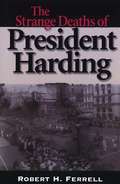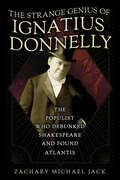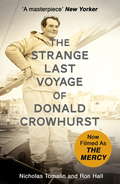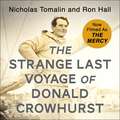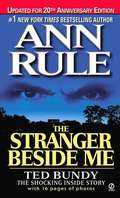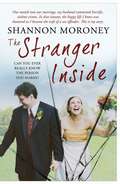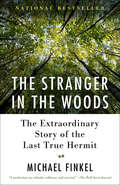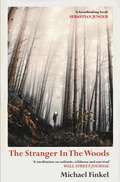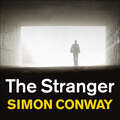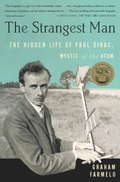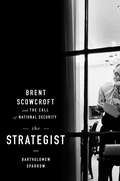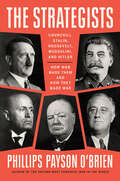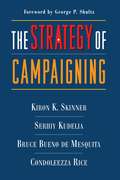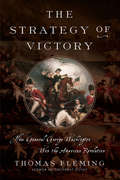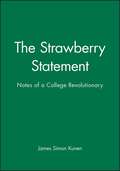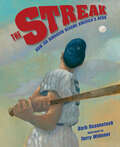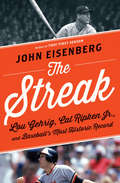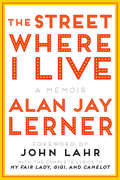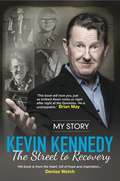- Table View
- List View
The Strange Deaths of President Harding
by Robert H. FerrellThe author, a noted presidential historian, re-examines the legends surrounding the death of Warren Harding and the corruption of his administration. Ferrell debunks the story that Harding was poisoned and questions whether he indeed fathered an illegitimate child. He shows how biographers and memoirists have fed the Harding legends since the 1920s, and tries to separate fact from fabrication.
The Strange Genius of Ignatius Donnelly: The Populist Who Debunked Shakespeare and Found Atlantis
by Zachary Michael JackThe Strange Genius of Ignatius Donnelly sheds light on the inimitable life of a neglected figure in US political and literary history. The father of American Populism, lieutenant governor of Minnesota, People's Party candidate for vice president, popularizer of the Shakespeare authorship controversy, proponent of the Atlantis theory, and author of bestselling speculative fictions, Ignatius Donnelly (1831–1901) positively defies categorization. Called a crank and a pseudoscientist by some and a genius by others, Donnelly broke all the rules. When skeptics said he was too green for politics, he got elected Minnesota's youngest-ever lieutenant governor. When they said a politician who prized his Irish heritage could never ascend to national office in a state dominated by conservative Scandinavians, he proved his critics wrong again. As Zachary Michael Jack' shows, in the latter half of Donnelly's remarkable life, he generated more fame and infamy than he had as a combative congressman. In an uncanny reversal of the usual midcareer doldrums, Donnelly turned political defeat into an opportunity for personal and professional reinvention, remaking himself as a visionary author and a champion of people-first third-party politics. The man known by enemies and friends alike as the Sage of Nininger pushed through poverty and ignominious defeat to introduce the masses to surprising theories about ancient civilizations, world-ending comets, and cryptograms purported to reveal the true authorship of Shakespeare's plays. At root, The Strange Genius of Ignatius Donnelly reveals the story of a man unafraid to speak truth to power, consequences be damned.
The Strange Last Voyage of Donald Crowhurst: Now Filmed As The Mercy
by Ron Hall Nicholas Tomalin'A masterpiece.' New Yorker'Wholly riveting, brilliantly researched.' Evening Standard'A meticulous investigation into the seeds of disaster... fascinating, uncomfortable reading.' Sunday Times In 1968, Donald Crowhurst was trying to market a nautical navigation device he had developed, and saw the Sunday Times Golden Globe round the world sailing race as the perfect opportunity to showcase his product. Few people knew that he wasn't an experienced deep-water sailor. His progress was so slow that he decided to short-cut the journey, while falsifying his location through radio messages from his supposed course.Everyone following the race thought that he was winning, and a hero's welcome awaited him at home in Britain. But on 10 July 1968, eight months after he set off, his wife was told that his boat had been discovered drifting in mid-Atlantic. Crowhurst was missing, assumed drowned, and there was much speculation that this was one of the great mysteries of the sea. In this masterpiece of investigative journalism, Nicholas Tomalin and Ron Hall reconstruct one of the greatest hoaxes of our time. From in-depth interviews with Crowhurst's family and friends and telling excerpts from his logbooks, Tomalin and Hall develop a tale of tragic self-delusion and public deception, a haunting portrait of a complex, deeply troubled man and his journey into the heart of darkness.
The Strange Last Voyage of Donald Crowhurst: Now Filmed As The Mercy
by Ron Hall Nicholas Tomalin'A masterpiece.' New Yorker'Wholly riveting, brilliantly researched.' Evening Standard'A meticulous investigation into the seeds of disaster... fascinating, uncomfortable reading.' Sunday Times In 1968, Donald Crowhurst was trying to market a nautical navigation device he had developed, and saw the Sunday Times Golden Globe round the world sailing race as the perfect opportunity to showcase his product. Few people knew that he wasn't an experienced deep-water sailor. His progress was so slow that he decided to short-cut the journey, while falsifying his location through radio messages from his supposed course.Everyone following the race thought that he was winning, and a hero's welcome awaited him at home in Britain. But on 10 July 1968, eight months after he set off, his wife was told that his boat had been discovered drifting in mid-Atlantic. Crowhurst was missing, assumed drowned, and there was much speculation that this was one of the great mysteries of the sea. In this masterpiece of investigative journalism, Nicholas Tomalin and Ron Hall reconstruct one of the greatest hoaxes of our time. From in-depth interviews with Crowhurst's family and friends and telling excerpts from his logbooks, Tomalin and Hall develop a tale of tragic self-delusion and public deception, a haunting portrait of a complex, deeply troubled man and his journey into the heart of darkness.
The Strange Last Voyage of Donald Crowhurst: Now Filmed As The Mercy
by Ron Hall Nicholas Tomalin'A masterpiece.' New Yorker'Wholly riveting, brilliantly researched.' Evening Standard'A meticulous investigation into the seeds of disaster... fascinating, uncomfortable reading.' Sunday Times In 1968, Donald Crowhurst was trying to market a nautical navigation device he had developed, and saw the Sunday Times Golden Globe round the world sailing race as the perfect opportunity to showcase his product. Few people knew that he wasn't an experienced deep-water sailor. His progress was so slow that he decided to short-cut the journey, while falsifying his location through radio messages from his supposed course.Everyone following the race thought that he was winning, and a hero's welcome awaited him at home in Britain. But on 10 July 1968, eight months after he set off, his wife was told that his boat had been discovered drifting in mid-Atlantic. Crowhurst was missing, assumed drowned, and there was much speculation that this was one of the great mysteries of the sea. In this masterpiece of investigative journalism, Nicholas Tomalin and Ron Hall reconstruct one of the greatest hoaxes of our time. From in-depth interviews with Crowhurst's family and friends and telling excerpts from his logbooks, Tomalin and Hall develop a tale of tragic self-delusion and public deception, a haunting portrait of a complex, deeply troubled man and his journey into the heart of darkness.(P)2016 Hodder & Stoughton
The Strange Last Voyage of Donald Crowhurst: The Strange Last Voyage Of Donald Crowhurst (Sailmate Ser.)
by Ron Hall Nicholas TomalinIn early 1968, desperate entrepreneur Donald Crowhurst was trying to sell a nautical navigation device he had developed when he saw that the Sunday Times would be sponsoring the Golden Globe Race, the first ever solo, round-the-world sailing competition. An avid amateur sailor, Crowhurst sensed a marketing opportunity and shocked the world by entering the competition using an untested trimaran of his own design. Shock soon turned to amazement when he quickly took the lead, checking in by radio message from locations far ahead of his seasoned competitors.But on July 10, 1969, roughly eight months after he had sailed from England--and less than two weeks from his expected triumphant return--his wife was informed that his boat, the Teignmouth Electron, had been discovered drifting quietly, abandoned in the middle of the Atlantic Ocean. Crowhurst was missing, assumed drowned. How did he come to such an end when his race had begun with such incredible promise?In this masterpiece of investigative journalism, Nicholas Tomalin and Ron Hall reconstruct one of the greatest modern stories of one man's descent into self-delusion, public deception, and madness. Based on in-depth interviews with Crowhurst's family and friends, combined with gripping excerpts from his logbooks that revealed (among other things) he had been falsifying his locations all along, Tomalin and Hall paint an unforgettable, haunting portrait of a complex, deeply troubled man and his final fateful journey.
The Stranger Beside Me (Updated 20th Anniversary Edition)
by Ann RuleOn January 24, 1989, Ted Bundy was put to death in Florida's electric chair for the murder of three young women, though he had confessed to murdering at least 35others as well. Ann Rule tells his story and the story of their friendship. [From the back cover.] Ann Rule was a writer working on the biggest story of her life, tracking down a brutal serial killer. Little did she know that the young man who was her close friend was the savage slayer she was hunting. Ted Bundy was everyone's picture of a natural "winner": handsome, charming, brilliant in law school, successful with women, on the verge of a dazzling career. On January 24, 1989, Ted Bundy was executed for the murders of three young women. He had also confessed to taking the lives of at least thirty-five more young women from coast to coast. This is his story, written by a woman who thought she knew Ted Bundy--until she began to pull all the evidence together, and the whole terrifying picture emerged from the dark depths. "The most fascinating killer in modern American history. ... Ann Rule has an extraordinary angle that makes The Stranger Beside Me as dramatic and chilling as a bedroom window shattering at midnight."--The New York Times
The Stranger Inside
by Shannon MoroneyWhen Shannon Moroney married Jason Staples in October 2005, she had no idea that her happy life as a newlywed was about to come crashing down around her. One month after her wedding, a police officer arrived at her hotel door while she was out of town with the news that her husband had been arrested and charged with the brutal sexual assault and kidnapping of two women, taking them to the house he shared with Shannon to commit the acts of violence. In the aftermath of the crimes, Shannon dealt with a heavy burden of grief, the stress and publicity of a major criminal investigation, and the painful stigma of guilt by association - all the while attempting to understand what had made Jason commit such violence. In this intimate and gripping journey into the human heart, Shannon reveals the far-reaching impact of Jason's crimes and the agonizing choices faced by the loved ones of offenders. She also tells the powerful story of how she made the amazing transition from being a member of the 'trauma club' to completely rebuilding her life. This is an impassioned, harrowing and ultimately hopeful story of one woman's pursuit of justice, forgiveness and healing.
The Stranger in the Mirror: A Memoir of Middle Age
by Jane ShillingMiddle age took Jane Shilling by surprise. She hadn't seen it coming, and she certainly wasn't ready for it. Living a flawed, bittersweet version of the idyll she dreamed of in her twenties, in a tumbledown urban cottage by the Thames, with a son, a cat and a horse in a livery fifty miles away, she wondered whether middle age was the beginning of the end. Or was there one last great adventure to be had? The Stranger in the Mirror is one woman's attempt to understand what middle age means for her and whether, as a new generation of women turns fifty, a revolution is under way. It definitely won't reverse the signs of ageing - but it will make you laugh, it will make you think and it could just make you look in the mirror in a slightly different way...
The Stranger in the Woods: The Extraordinary Story of the Last True Hermit
by Michael FinkelNEW YORK TIMES BESTSELLER • The remarkable true story of a man who lived alone in the woods of Maine for 27 years, making this dream a reality—not out of anger at the world, but simply because he preferred to live on his own.&“A meditation on solitude, wildness and survival.&” —The Wall Street JournalIn 1986, a shy and intelligent twenty-year-old named Christopher Knight left his home in Massachusetts, drove to Maine, and disappeared into the forest. He would not have a conversation with another human being until nearly three decades later, when he was arrested for stealing food. Living in a tent even through brutal winters, he had survived by his wits and courage, developing ingenious ways to store edibles and water, and to avoid freezing to death. He broke into nearby cottages for food, clothing, reading material, and other provisions, taking only what he needed but terrifying a community never able to solve the mysterious burglaries. Based on extensive interviews with Knight himself, this is a vividly detailed account of his secluded life—why did he leave? what did he learn?—as well as the challenges he has faced since returning to the world. It is a gripping story of survival that asks fundamental questions about solitude, community, and what makes a good life, and a deeply moving portrait of a man who was determined to live his own way, and succeeded.
The Stranger in the Woods: The extraordinary story of the last true hermit
by Michael Finkel*THE NEW YORK TIMES BESTSELLER* Could you leave behind all that you know and live in solitude for three decades? This is the extraordinary story of the last true hermit - Christopher Knight. 'This was a breath-taking book to read and many weeks later I am still thinking about the implications for our society and - by extension - for my own life' Sebastian Junger, bestselling author of The Perfect Storm 'A wry meditation on one man's attempt to escape life's distractions and look inwards, to find meaning not by doing, but by being' Martin Sixsmith, bestselling author of Philomena and Ayesha's Gift 'Not all heroes wear capes. My latest one is a man called Christopher Knight – a silent idol for anyone who has felt the urge to just sack it all off and live the life of a hermit' Lucy Mangan, Stylist 'An extraordinary story about solitude, community, identity and freedom' Guardian 'A meditation on solitude, wildness and survival. It is also, unexpectedly, a tribute to the joys of reading' The Wall Street Journal In 1986, twenty-year-old Christopher Knight left his home in Massachusetts, drove to Maine, and disappeared into the woods.He would not speak to another human being until three decades later when he was arrested for stealing food. Christopher survived by his wits and courage, developing ingenious ways to store food and water in order to avoid freezing to death in his tent during the harsh Maine winters. He broke into nearby cottages for food, clothes, reading material and other provisions, taking only what he needed. In the process, he unwittingly terrified a community unable to solve the mysterious burglaries. Myths abounded amongst the locals eager to find this legendary hermit. Based on extensive interviews with Knight himself, this is a vividly detailed account of his secluded life and the challenges he faced returning to the world. The Stranger in the Woods is a riveting story of survival that asks fundamental questions about solitude and what makes for a good life.Above all, this is a deeply moving portrait of a man determined to live life his own way.
The Stranger: A Sunday Times new golden age of spy fiction novel (Jude Lyon #1)
by Simon ConwayThe new novel from the CWA Ian Fleming Steel Dagger award-winning author of A Loyal SpyISIS can't control him.MI6 can't find him.But he's coming...Things change quickly in the world of espionage and clandestine operations. Jude Lyon of MI6 remembers the captured terrorist bomb-maker. He watched him being flown off to Syria, back when Syria was 'friendly'. No-one expected him to survive interrogation there.Yet the man is alive and someone has broken him out of jail.Bad news for the former foreign secretary who authorised his rendition. And Jude's boss Queen Bee who knew he wasn't a terrorist at all, but an innocent bystander. Now she calls Jude back from a dangerously enjoyable mission involving a Russian diplomat's wife.He has a new job: close down this embarrassment. Fast.But embarrassment is only the beginning. Someone is using the former prisoner to front a new and unspeakably terrifying campaign. Someone not even ISIS can control.He is like a rumour, a myth, a whisper on the desert wind. But he is real and he is coming for us ...He is the genius known only as ... The Stranger.From the corridors of Westminster to the refugee camps of Jordan, the back streets of East London to the badlands of Iraq, The Stranger is a nerve-shredding journey of suspense as Jude Lyon pieces together the shape of an implacable horror coming towards him - and a conspiracy of lies behind him.(P) 2020 Hodder & Stoughton Ltd
The Strangest Man: The Hidden Life of Paul Dirac, Mystic of the Atom
by Graham FarmeloPaul Dirac was among the great scientific geniuses of the modern age. One of the discoverers of quantum mechanics, the most revolutionary theory of the past century, his contributions had a unique insight, eloquence, clarity, and mathematical power. His prediction of antimatter was one of the greatest triumphs in the history of physics. One of Einstein's most admired colleagues, Dirac was in 1933 the youngest theoretician ever to win the Nobel Prize in physics. Dirac's personality is legendary. He was an extraordinarily reserved loner, relentlessly literal-minded and appeared to have no empathy with most people. Yet he was a family man and was intensely loyal to his friends. His tastes in the arts ranged from Beethoven to Cher, from Rembrandt to Mickey Mouse. Based on previously undiscovered archives, The Strangest Man reveals the many facets of Dirac's brilliantly original mind. A compelling human story, The Strangest Man also depicts a spectacularly exciting era in scientific history.
The Strategist: Brent Scowcroft and the Call of National Security
by Bartholomew SparrowBased on the full cooperation of the subject--with no restraining conditions--The Strategist provides an in-depth portrait of a man whose career has been intimately linked to the great transformations in U. S. foreign policy, from the last third of the Cold War, to September 11, 2001, and up to the present. Bartholomew Sparrow brings color and focus to the complex and often secretive nature of U. S. foreign policy and strategic adjustments--an intellectual battlefield on which ideas and worldviews clash, in which economics, politics, and strategic concerns intertwine, and in which private citizens and non-office holders may exert as much influence as highly visible Cabinet officials. Among the most important foreign policy minds of the 20th and early 21st centuries, Brent Scowcroft is also among the least well-known or understood. In a now-famous August 2002 Wall Street Journal op-ed titled "Don’t Attack Saddam Hussein,” Brent Scowcroft, who had been national security advisor under President George H. W. Bush, went to war himself, in a sense, with his closest and longest-standing friends. He noted the scant evidence that tied the Iraqi government to terrorist organizations. He warned that an invasion and occupation of Iraq would be costly and potentially disastrous for a variety of carefully considered reasons. He recommended that the Bush administration work with the U. N. Security Council and wait for definitive proof of Saddam’s wrongdoing before taking action. The essay at once made Scowcroft the most outspoken and most credible critic of the Bush administration’s plans for war and immediately generated national controversy. It provoked a sudden, deep split in the Republican Party over the plans for war. Vice President Cheney, National Security Advisor Rice, Defense Secretary Rumsfeld, and President George W. Bush all vigorously reaffirmed their cause and their course of action, and the media and American public opinion soon fell in line. Clearly, Scowcroft, 84, continues to participate in the most central and important debates over U. S. foreign policy and national security. He has been a leading architect of U. S. foreign policy and grand strategy for almost a half-century, and though long out of office, still gives speeches, makes media appearances, and leads tasks forces and commissions. He is a rare creature, one of the few "wise men” of the nation’s capital: someone who is regularly consulted by top government officials in Democratic and Republican administrations, ranking members of the House and Senate from both sides of the aisle, and the country’s leading foreign-policy journalists. As recently as April 2009, Scowcroft co-chaired an extensive Council of Foreign Relations study of the U. S. nuclear weapons policy. More than anyone else, he stands at the center of the United States’ foreign policy establishment. Most significantly, Scowcroft is trusted--a scarce and typically fleeting quality in Washington--and has been for four decades. The unprecedented insights into the man and his career Sparrow offers in The Strategist are vital to anyone who wishes to understand America's changing role in the world.
The Strategists: Churchill, Stalin, Roosevelt, Mussolini, and Hitler--How War Made Them and How They Made War
by Phillips Payson O'BrienChurchill. Hitler. Stalin. Mussolini. Roosevelt. Five of the most impactful leaders of WW2, each with their own individualistic and idiosyncratic approach to warfare. But if we want to understand their military strategy, we must first understand the strategist.In The Strategists, Professor Phillips Payson O'Brien shows how the views these five leaders forged in WW1 are crucial to understanding how they fought WW2. For example, Churchill's experiences of facing the German Army in France in 1916 made him unwilling to send masses of British soldiers back there in the 1940s, while Hitler's mistakes on the Eastern Front were influenced by his reluctance to accept that conditions had changed since his own time fighting. The implications of the power of leaders remain with us to this day: to truly understand what is happening in Ukraine, for example, requires us to know what has influenced the leaders involved.This is a history in which leaders—and their choices—matter. For better or worse.
The Strategy of Campaigning: Lessons from Ronald Reagan and Boris Yeltsin
by Bruce Bueno de Mesquita Kiron K. Skinner Condoleezza Rice Serhiy KudeliaThe Strategy of Campaigningexplores the political careers of Ronald Reagan and Boris Yeltsin, two of the most galvanizing and often controversial political figures of our time. Both men overcame defeat early in their political careers and rose to the highest elected offices in their respective countries. The authors demonstrate how and why Reagan and Yeltsin succeeded in their political aspirations, despite-or perhaps because of-their apparent "policy extremism": that is, their advocacy of policy positions far from the mainstream. The book analyzes the viability of policy extremism as a political strategy that enables candidates to forge new coalitions and outflank conventional political allegiances. Kiron K. Skinner is Associate Professor of International Relations and Political Science at Carnegie Mellon University, a Research Fellow at the Hoover Institution, and a member of the Chief of Naval Operations Executive Panel and the National Security Education Board. Serhiy Kudelia is Lecturer of Politics at Kyiv-Mohyla Academy, Ukraine and advisor to Deputy Prime Minister of Ukraine. Bruce Bueno de Mesquita is Julius Silver Professor and Director of the Alexander Hamilton Center for Political Economy at New York University and a Senior Fellow at the Hoover Institution. Condoleezza Rice is on a leave of absence from Stanford University, where she was a Professor of Political Science and a Senior Fellow at the Hoover Institution. She is currently serving as U. S. Secretary of State.
The Strategy of Victory: How General George Washington Won the American Revolution
by Thomas FlemingA sweeping and insightful grand strategic overview of the American Revolution, highlighting Washington's role in orchestrating victory and creating the US ArmyLed by the Continental Congress, the Americans almost lost the war for independence because their military thinking was badly muddled. Following the victory in 1775 at Bunker Hill, patriot leaders were convinced that the key to victory was the home-grown militia--local men defending their families and homes. But the flush of early victory soon turned into a bitter reality as the British routed Americans fleeing New York.General George Washington knew that having and maintaining an army of professional soldiers was the only way to win independence. As he fought bitterly with the leaders in Congress over the creation of a regular army, he patiently waited until his new army was ready for pitched battle. His first opportunity came late in 1776, following his surprise crossing of the Delaware River. In New Jersey, the strategy of victory was about to unfold.In The Strategy of Victory, preeminent historian Thomas Fleming examines the battles that created American independence, revealing how the creation of a professional army worked on the battlefield to secure victory, independence, and a lasting peace for the young nation.
The Strawberry Statement
by James S. KunenWriting from the vantage point of a priveleged middleclass student attending columbia University during the Vietnam War in the 1960's, the author is transformed from a "conformist" "Jock" into a politically and Socially Radical "Puke". He also experiences his first Romance, finds that changes is harder to accomplish than idealism might indicate, and rarely pure... He also reflects upon his writing and experiences with 40 years of life behind the point where he authored the book...
The Stray Bullet: William S. Burroughs in Mexico
by Jorge García-RoblesWilliam S. Burroughs arrived in Mexico City in 1949, having slipped out of New Orleans while awaiting trial on drug and weapons charges that would almost certainly have resulted in a lengthy prison sentence. Still uncertain about being a writer, he had left behind a series of failed business ventures—including a scheme to grow marijuana in Texas and sell it in New York—and an already long history of drug use and arrests. He would remain in Mexico for three years, a period that culminated in the defining incident of his life: Burroughs shot his common-law wife, Joan Vollmer, while playing William Tell with a loaded pistol. (He would be tried and convicted of murder in absentia after fleeing Mexico.)First published in 1995 in Mexico, where it received the Malcolm Lowry literary essay award, The Stray Bullet is an imaginative and riveting account of Burroughs&’s formative experiences in Mexico, his fascination with Mexico City&’s demimonde, his acquaintances and friendships there, and his contradictory attitudes toward the country and its culture. Mexico, Jorge García-Robles makes clear, was the place in which Burroughs embarked on his &“fatal vocation as a writer.&”Through meticulous research and interviews with those who knew Burroughs and his circle in Mexico City, García-Robles brilliantly portrays a time in Burroughs&’s life that has been overshadowed by the tragedy of Joan Vollmer&’s death. He re-creates the bohemian Roma neighborhood where Burroughs resided with Joan and their children, the streets of postwar Mexico City that Burroughs explored, and such infamous figures as Lola la Chata, queen of the city&’s drug trade. This compelling book also offers a contribution by Burroughs himself—an evocative sketch of his shady Mexican attorney, Bernabé Jurado.
The Streak: How Joe DiMaggio Became America's Hero
by Terry Widener Barb RosenstockIn the summer of 1941, Yankee center fielder Joe DiMaggio and his favorite bat, Betsy Ann, begin the longest hitting streak in baseball history. But when Betsy Ann goes missing, will DiMaggio keep hitting? Set on the brink of World War II, this is a spellbinding account of a sports story that united the country and made DiMaggio a hero, at a time when one was profoundly needed. Barb Rosenstock's action-packed text and Terry Widener's powerful illustrations capture DiMaggio's drive as well as his frustration. The book also includes headlines, quotes, stats, and a detailed bibliography.
The Streak: Lou Gehrig, Cal Ripken Jr., and Baseball's Most Historic Record
by John Eisenberg&“A line-drive hit of a book&” about the Iron Horse and the Iron Man—two legends from two eras of baseball—and the nature of human endurance (The Wall Street Journal).When Cal Ripken Jr. began his career with the Baltimore Orioles at age twenty-one, he had no idea he would someday beat the historic record of playing 2,130 games in a row, a record set forty-two years before by the fabled &“Iron Horse&” of the New York Yankees, Lou Gehrig. Ripken went on to surpass that record by 502 games, and the baseball world was floored. Few feats in sports history have generated more acclaim. But the record spawns an array of questions. When did someone first think it was a good idea to play in so many games without taking a day off? Who owned the record before Gehrig? Whose streak—Gehrig&’s or Ripken&’s—was the more difficult achievement? Through probing research, meticulous analysis, and colorful parallel storytelling, The Streak delves into this impressive but controversial milestone, unraveling Gehrig&’s at-times unwitting pursuit of that goal (Babe Ruth used to think Gehrig crazy for wanting to play every game), and Ripken&’s fierce determination to stay in the lineup and continue to contribute whatever he could even as his skills diminished with age. So many factors contribute to the comparisons between the two men: the length of seasons, the number of teams in the major leagues, the inclusion of nonwhite players, travel, technology, medical advances, and even media are all part of the equation. This is a book that captures the deeply American appreciation—as seen in the sport itself—for a workaday mentality and that desire to be there for the game every time it called.&“It tackles the allure of human endurance and the pitfalls of fame, but it is mostly a baseball book for baseball fans. It succeeds as both a thorough accounting and a love note to the game.&”—The Washington Post
The Street Dog Who Found a Home
by Barby KeelA heartwarming true animal story, for fans of A Dog's Purpose, A Street Cat Named Bob and Marley & Me.When Chewy the dog arrives at the animal sanctuary run by the inimitable Barby Keel, the scrawny little dog is terrified. Having been abandoned by his beloved owner, who is himself homeless, Chewy's whole world has been turned upside down. After years of sleeping on the streets, Chewy knows what it is to be cold and hungry, to have nowhere safe to stay, no warm bed to sleep on, no regular food or time to play. Despite her resolve to not get too attached to the animals that come into her care, Barby cannot help but feel there is something special about this little dog. Soon he won't let Barby out of his sight, and in doing so works his way into her heart. But some scars run too deep and it takes every ounce of Barby's patience to help Chewy heal from the traumas of his past. In doing so, Barby learns that in healing others, we often heal ourselves. A Street Cat Named Bob meets Marley & Me, The Street Dog Who Found a Home is a beautifully uplifting and heartwarming tale of the love and friendship that exists between humans and animals.
The Street Dog Who Found a Home (A Foster Tails Story)
by Barby KeelA heartwarming true animal story, for fans of A Dog's Purpose, A Street Cat Named Bob and Marley & Me. When Chewy the dog arrives at the animal sanctuary run by the inimitable Barby Keel, the scrawny little dog is terrified. Having been abandoned by his beloved owner, who is himself homeless, Chewy's whole world has been turned upside down. After years of sleeping on the streets, Chewy knows what it is to be cold and hungry, to have nowhere safe to stay, no warm bed to sleep on, no regular food or time to play. Despite her resolve to not get too attached to the animals that come into her care, Barby cannot help but feel there is something special about this little dog. Soon he won't let Barby out of his sight, and in doing so works his way into her heart. But some scars run too deep and it takes every ounce of Barby's patience to help Chewy heal from the traumas of his past. In doing so, Barby learns that in healing others, we often heal ourselves. A Street Cat Named Bob meets Marley & Me, The Street Dog Who Found a Home is a beautifully uplifting and heartwarming tale of the love and friendship that exists between humans and animals.
The Street Where I Live: A Memoir (Pop Concert Full Orchestra Ser.)
by Alan J. Lerner“Lerner will always be remembered as a Broadway light, and one of the brightest.” —Tom Shales, The Washington Post The Street Where I Live is at once an intimate biography of three great shows—My Fair Lady, Gigi, and Camelot—and a candid account of the life and times of Alan J. Lerner, one of America’s most acclaimed and popular lyricists. Large-hearted, humorous, and often poignant in its reverence for a celebrated era in the American theater, this is the story of what Lerner calls "the sundown of wit, eccentricity, and glamour." Try as he might to keep himself out of these pages, Lerner reveals himself to be a man of great talent, laughter, and love. Along the way, we meet a sensational supporting cast: Moss Hart, Fritz Loewe, Julie Andrews, Richard Burton, Rex Harrison, Cecil Beaton, Louis Jourdan, and Maurice Chevalier, to name a few. They are seen in moments of triumph and disaster, but all are professionals at the creation of theater. And the creation of theater is the matrix of this wonderful book. Included are the complete lyrics to My Fair Lady, Gigi, and Camelot.
The Street to Recovery
by Kevin KennedyCurly Watts is a TV icon - for twenty years appearing on millions of TV screens around the country in Coronation Street. Kevin Kennedy is one of the UK's most successful soap actors, although behind the scenes and high-profile appearances, he faced a painful personal battle.Kevin shares his experiences of alcoholism, rehab and IVF as well stories from the set and stars he worked with during some of the brightest, and darkest moments of his life, through to his music career and current roles.This brutally honest autobiography provides a rare glimpse into life behind the scenes, the power of addiction, and his battle with recovery.
